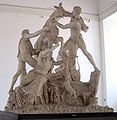Farnese Bull

The Farnese Bull (
This colossal
, who wanted to punish Dirce for the ill-treatment inflicted on their mother.Rediscovery and reconstruction

The group was unearthed in 1546 during excavations at gymnasium of the Roman
Unlike the discoveries of the Farnese Hercules and the Latin Hercules from this excavation, which were documented as to their location, the only reference to this grouping is from a 1595 engraving by Etienne du Perac of the ruins of the Baths, showing the end of the east palestra, which states: "...in the time of Paul III many beautiful fragments of statues and animals were found that were all in one piece in antiquity ... and Cardinal Farnese had [it] erected now in his Palazzo."[4]
The group underwent a substantial restoration in the 16th century, when Michelangelo planned to use it for a fountain to be installed at the centre of a garden between Palazzo Farnese and the Villa Farnesina.[5] It also could have been adapted for this use soon after it was found, which is supported by descriptions from the Renaissance era.[6] Further restorations were made in the 18th and 19th centuries. In 1883, the original sculpture was noted by Domenico Monaco, curator of the (then) National Museum in Naples, to have been carved from a block of marble measuring 3.66 m × 2.75 m ("12 ft by 9 ft.");[7] after its restorations, the work's perimeter is approximately 3.3 m (10'10") on each side and over 4 m (13') high. As it is today, the sculpture weighs 21.8 tonnes (24 short tons).[8]
It has been argued that the sculpture noted by Pliny in his Natural History could not be the Farnese Bull, which is instead a 3rd-century AD Roman version, made specifically for Caracalla's Baths.[8][9] Other scholars dispute this, arguing that since the work was originally located in the nearby Horti Asiniani, or Asiniani gardens, which the Pollio family owned, to have commissioned a copy specifically for the Baths would have meant both pieces would have been displayed in very close proximity.[10]
It is shown in the 1954 film Journey to Italy along with the Farnese Hercules. Henry Peacham, in The Compleat Gentleman, says that it "out-strippeth all other Statues in the world for greatnesse and workemanship".[11]
-
The Farnese Bull as it was depicted in the Encyclopædia Britannica (11th ed.), v. 12, 1911, Plate I, between pp. 480 and 481 (or pp. 472 and 473 depending on edition), Fig. 51.
-
An oblique front view of the Farnese Bull. Note that lighting greatly affects the appearance of the marble.
-
A detail view of the bull's head and the male figure holding it by the horns.
-
Front view, taken largely in natural light.
-
A front view, taken primarily using artificial light.
-
A side view showing a standing female figure that is obscured when the piece is viewed from the front.
-
A back view, showing further detail in the base, support for one of the male figures, and the standing female figure.
-
Berlin-Charlottenburg, Germany
Notes
- ^ Smith, 108
- ^ Pliny the Elder, Natural History, xxxvi.33-34; Smith, 108
- ^ Stefano De Caro, The National Archaeological Museum of Naples (Napoli: Electa, 2001), p. 334.
- ^ Rudolpho Lanciani, Forma Urbis Romae, 1893-1901, vol. II, 201, fig. 129.
- ^ Stefano De Caro, The National Archaeological Museum of Naples (2001), p. 334.
- ^ E. Pozzi, (ed), Il Toro Farnese; "La montagna di marmo" tra Roma e Napoli, 1991, p. 63.
- ^ Monaco, Domenico (1883). A Complete Handbook to the National Museum in Naples, According to the New Arrangement. Translated by Rolfe, Eustace Neville (3rd ed.). William Clowes and Sons. p. 27. Retrieved February 13, 2018.
- ^ a b
Haskell, Francis; Penny, Nicholas (1981). Taste and the Antique: The Lure of Antique Sculpture 1500–1900. Yale University Press. ISBN 978-0-300-02913-0.
- ^ Miranda Marvin, "Freestanding Sculpture in the Baths of Caracalla, American Journal of Archaeology, Vol. 87, No. 3, Jul., 1983, p. 380.
- ^ E. La Rocca, "Artisti rodici negli horti romani", CIMA, 1998, p. 203-274.
- ^ Andrews, Robyn P. (1982). A Critical Edition of The Compleat Gentleman (1622) by Henry Peacham (PDF). p. 119. Retrieved 12 April 2023.
References
- Smith, R.R.R., Hellenistic Sculpture, a handbook, Thames & Hudson, 1991, ISBN 0500202494








